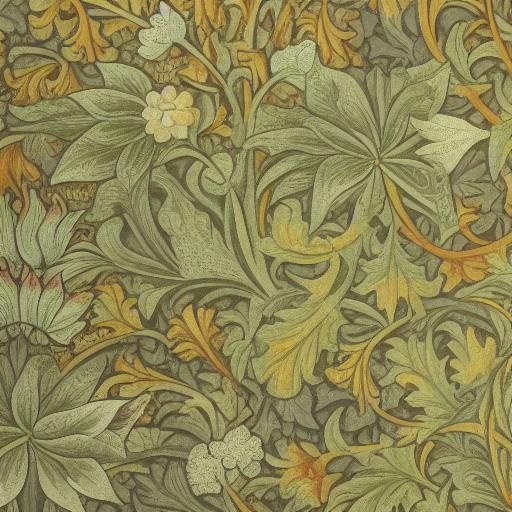Merging of colors
The blending and changing of colors, such as green transitioning into yellow, create a sense of depth, dimension, and movement within the design. It mimics the way light interacts with leaves in nature, as they change color with variations in lighting and seasonal shifts. This dynamic coloration adds a lifelike quality to the leaves, making them appear more vibrant and realistic.
Furthermore, the blending of colors in Art Nouveau patterns can be seen as a reflection of the artistic philosophy of the movement. Art Nouveau sought to integrate art with nature, emphasizing the harmony and interconnectedness of the two. By blending colors seamlessly, the artwork achieves a harmonious balance between the natural world and artistic expression.
The merging of green and yellow tones in Art Nouveau patterns is not only an aesthetic choice but also a deliberate attempt to capture the beauty and essence of nature. It creates a visual experience that is both captivating and evocative, enhancing the overall appeal of the artwork and reinforcing the organic and flowing nature of the Art Nouveau style.
How to create the patterns with AI Image Generator and prompt
When creating captivating and visually appealing wallpapers, it is essential to explore the capabilities of digital rendering techniques with AI image generators like Imagen and DALL-E. By incorporating elements from the Arts and Crafts movement and the distinctive style of William Morris, we can create stunning digital renderings that pay homage to the rich tradition of his prints.
Let’s delve into the various aspects of the prompt and their influence on the resulting artwork:
- A close-up of a wallpaper with flowers and leaves: This focal point allows us to appreciate the intricate details and vibrant colors of the floral and botanical motifs. The close-up perspective adds depth and invites viewers to immerse themselves in the artwork.
- A digital rendering by William Morris: Drawing inspiration from the renowned artist and designer William Morris, we can infuse the artwork with his signature style. Morris was known for his intricate patterns, meticulous craftsmanship, and emphasis on nature-inspired designs.
- Arts and Crafts movement: The Arts and Crafts movement, which flourished in the late 19th and early 20th centuries, promoted handmade craftsmanship and celebrated the beauty of nature in design.
- William Morris style and style of William Morris print: These mentions reinforce the influence of William Morris’s distinctive artistic style. It encompasses organic forms, repetitive patterns, and a harmonious interplay between floral elements and geometric shapes.
- Art Nouveau wallpaper: The inclusion of Art Nouveau highlights the decorative and ornamental nature of the wallpaper design. Art Nouveau is characterized by flowing lines, intricate details, and a synthesis of natural and abstract motifs.
By utilizing digital rendering techniques, we can breathe new life into traditional wallpaper designs. The digital medium allows for precise control over details, color palettes, and textures, resulting in captivating and visually immersive artwork. With the influence of William Morris’s style and the incorporation of elements from the Arts and Crafts movement and Art Nouveau, we can create wallpapers that evoke a sense of beauty, craftsmanship, and a connection to nature.
Once the artwork is completed, it can be shared and appreciated on different platforms. Furthermore, with design tools like Visual Paradigm Online, we have the flexibility to further customize and refine the digital rendering, unleashing our creativity and exploring endless possibilities in the world of wallpaper design.
About William Morris
William Morris was a renowned British artist, designer, and writer who played a significant role in the Arts and Crafts movement and the development of Art Nouveau. Born in 1834, Morris is known for his multifaceted talents and his contributions to various creative fields.
As a designer, Morris embraced a philosophy of craftsmanship and sought to revive traditional methods of production. He founded the design firm Morris, Marshall, Faulkner & Co., later known as Morris & Co., which produced a wide range of decorative arts, including wallpaper, textiles, furniture, stained glass, and bookbinding. His designs were characterized by intricate patterns inspired by nature, medieval influences, and a rich color palette.
Other Famous artists in Art Nouveau
While William Morris is a prominent figure associated with Art Nouveau, there were many other artists and designers who contributed to the movement. Here are a few other notable art styles within Art Nouveau:
Alphonse Mucha
Alphonse Mucha is renowned for his distinctive Art Nouveau style, characterized by intricate line work, decorative patterns, and elegant female figures. His work often featured elongated proportions, flowing hair, and ornate details, capturing the essence of beauty and sensuality.
René Lalique
René Lalique was a renowned French glass artist and jeweler who embraced Art Nouveau aesthetics. His creations incorporated organic forms, such as flowing curves, intricate floral motifs, and the use of materials like glass and enamel. Lalique’s work emphasized craftsmanship and the fusion of art with everyday objects.
Émile Gallé
Émile Gallé was a prominent French glass artist known for his intricate glasswork inspired by nature. His pieces often showcased intricate botanical motifs, such as flowers, leaves, and insects, rendered with delicate details and vibrant colors. Gallé’s work exemplified the fusion of artistry and technical skill.
Hector Guimard
Hector Guimard was an influential French architect and designer who played a significant role in defining the Art Nouveau style in architecture. He is best known for his iconic Paris Metro entrances, featuring organic forms, flowing lines, and ornamental details inspired by nature.
These are just a few examples of the diverse range of art styles within the broader Art Nouveau movement. Each artist brought their unique interpretation to the style, incorporating elements such as nature, symbolism, and decorative motifs to create visually stunning and distinctive artworks.


